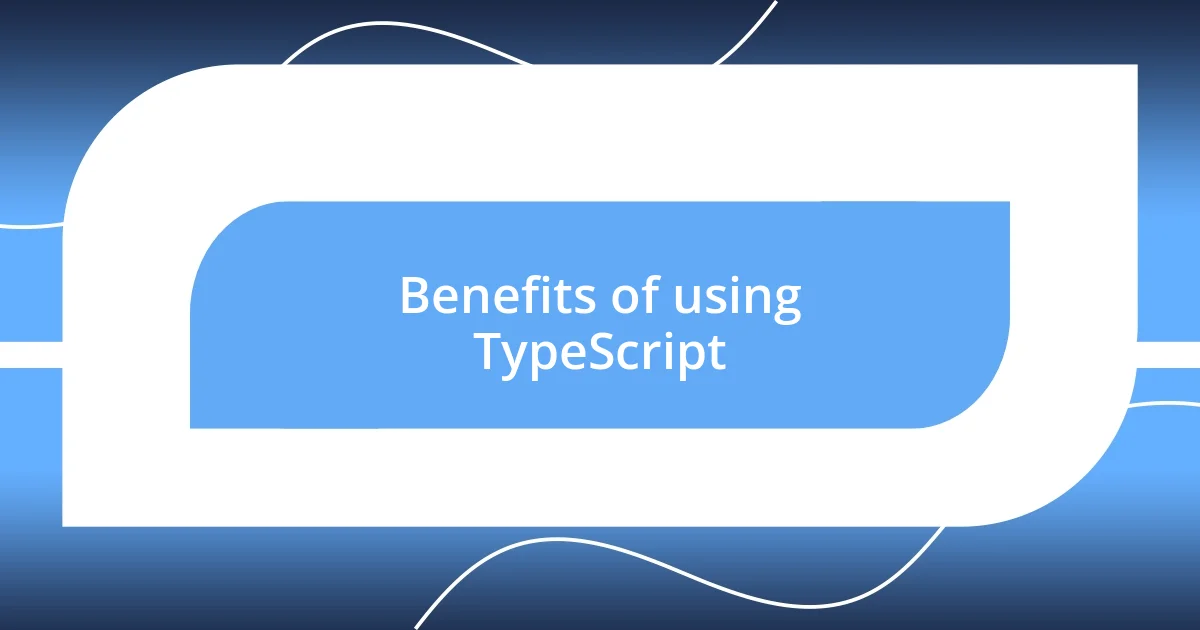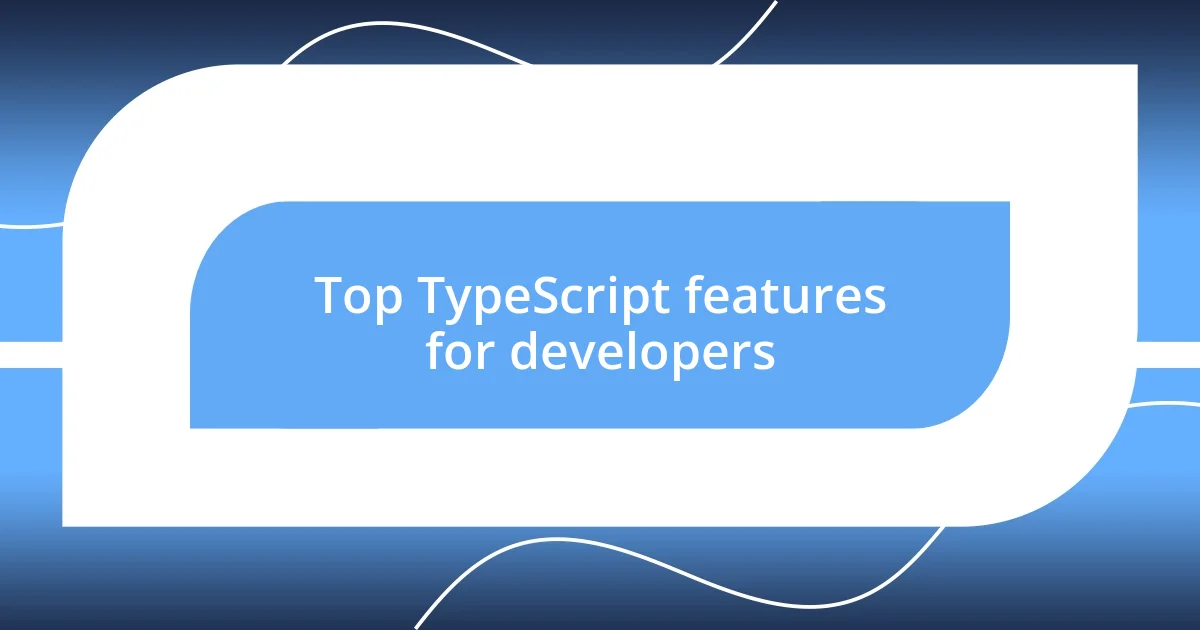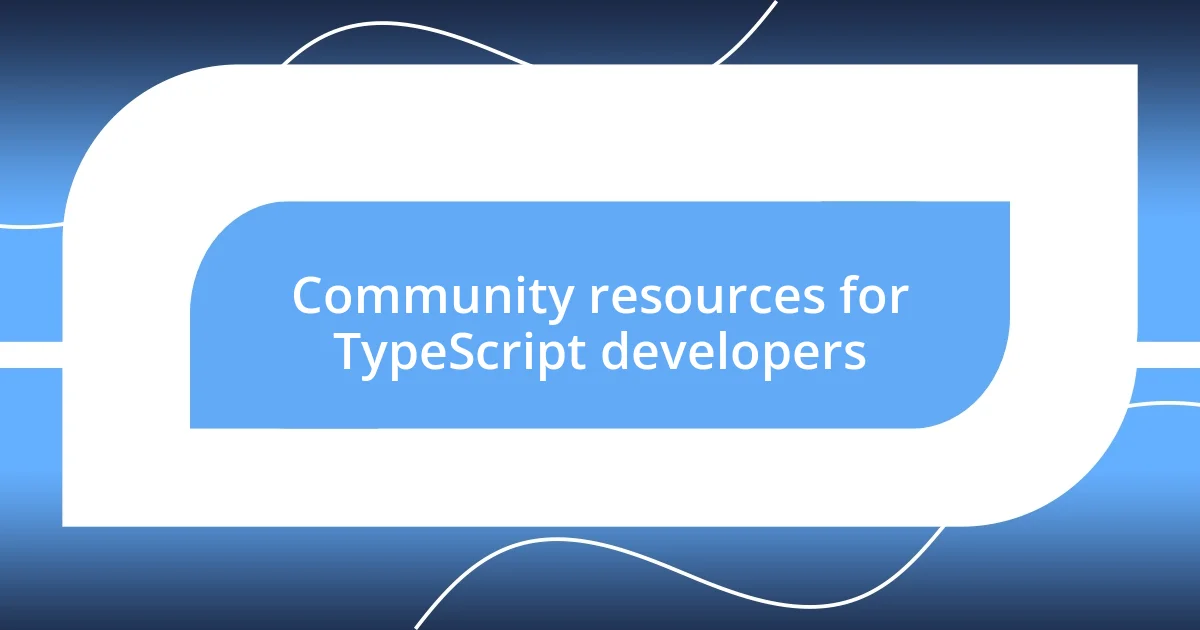Key takeaways:
- TypeScript enhances the JavaScript experience by providing static typing, which reduces runtime errors and improves code clarity, making collaboration easier.
- Key features such as custom types, async/await, and enhanced tooling support transform development workflows, leading to cleaner, more maintainable code.
- The strong TypeScript community offers a wealth of resources, including forums and live discussions, providing support and shared solutions to common challenges faced by developers.

Introduction to TypeScript features
When I first started using TypeScript, I was struck by how it elevates the JavaScript experience with a type system that helps catch errors before they escalate. Imagine writing code and having the confidence that it’s less likely to break when it’s running. That’s precisely what TypeScript offers—a safety net that allows developers like me to focus on creativity rather than debugging.
One feature that I find particularly appealing is the ability to define interfaces and types. It’s like having a well-structured layout before building a house. Each part of your code has a clear purpose and role, which not only helps in organizing thoughts but also makes collaboration with teammates a breeze. Have you ever tried working on a project where no one knew who was responsible for what? It’s chaotic! With TypeScript, I always feel that clarity reigns.
Then there are the advanced features like generics, which I initially found daunting but now appreciate deeply. They allow you to write more flexible and reusable functions and classes. When I grasped generics, it felt like unlocking a new level in a game—suddenly, I had access to powerful tools that made my code not just functional, but elegantly designed. Don’t you love that moment when everything clicks into place? That’s what TypeScript can offer: a blend of security and flexibility that every developer craves.

Benefits of using TypeScript
TypeScript offers a unique advantage with its static typing, which substantially reduces runtime errors. I remember a particular project where I transitioned from JavaScript to TypeScript halfway through. The moment I started leveraging the type system, those pesky bugs that used to sneak in during runtime became so much easier to identify during development. It was like switching on a light in a dimly lit room—everything became clearer.
Another benefit that stands out to me is its enhanced tooling support. With TypeScript, editors and IDEs provide better autocompletion and in-context documentation. There’s something incredibly satisfying about writing code and seeing hints that guide you without having to constantly refer to documentation. It’s almost like having a subtle mentor standing beside you, nudging you in the right direction. I can’t stress enough how this feature has improved my coding experience, making me more productive and confident in my work.
Lastly, TypeScript’s popularity has fostered a large community and a wealth of resources. This means if you ever hit a snag, there’s a good chance someone else has faced the same issue and shared their solution online. I’ve often found myself saved by online discussions on forums or tutorials, which have been a fantastic resource as I navigated challenging projects. Having that safety net of community support provides a sense of belonging and reassurance—knowing you’re not alone on your coding journey.
| Feature | Benefit |
|---|---|
| Static Typing | Reduces runtime errors and increases confidence in code stability |
| Enhanced Tooling | Provides better autocompletion and in-context documentation |
| Strong Community Support | Access to resources and shared solutions for common problems |

Top TypeScript features for developers
One of my favorite TypeScript features is the ability to create custom types. I remember a project in which we handled a complex data structure that included various states and properties. Defining custom types allowed me to clarify each aspect of the structure and keep everything organized. It felt like finally putting together a jigsaw puzzle where each piece had its designated spot, making collaboration effortless. Additionally, the strict checks at compile-time meant I could quickly identify errors without having to sift through endless lines of code.
Here are some standout features that every TypeScript developer should appreciate:
- Custom Types: Enhance code clarity and maintainability by defining clear structures.
- Enums: Provide a way to define named constants, which makes the code more readable.
- Access Modifiers: Control the visibility of properties and methods, allowing better encapsulation and enhancing security in your code.
Another gem that I adore is the support for async/await syntax. When I first encountered asynchronous programming in JavaScript, it felt like I was juggling too many balls in the air. The moment I started using TypeScript’s async/await, everything fell into place—it transformed how I approached asynchronous tasks. The code became cleaner and easier to follow, and I vividly remember the thrill of watching my promise chains reduce to simple, readable lines. It felt liberating—like trading in a messy kitchen for a well-organized workspace.
- Async/Await: Simplifies asynchronous code, making it easier to write and understand.
- Type Narrowing: Enhances code safety by automatically narrowing down types based on conditional checks.
- Mapped Types: Allow dynamic creation of new types based on existing ones, adding flexibility to your type system.
Embracing these features has reshaped my development process, boosting my productivity and leaving me excited for every new project.

Strong typing for better code
Strong typing in TypeScript is like having a well-organized toolbox—it helps you quickly find the right tool for the job. I once worked on a team project where we were juggling multiple data types and interfaces, and the static typing caught a significant number of mismatched data types before we even ran the code. It felt like a safety net was there, catching us before we fell into a pit of unexpected bugs. Can you imagine tackling a big project without that kind of assurance?
The type system encourages a certain discipline in coding that I genuinely appreciate. By explicitly defining types, I found I could articulate my intentions more clearly to both the compiler and my teammates. There’s a sense of pride that comes with writing code that is both understandable and robust. It reminds me of the satisfaction I get from mapping out a detailed plan before diving into a complex task—there’s less room for ambiguity.
Working with TypeScript has also opened my eyes to the beauty of catching errors at compile time rather than at runtime. One time, while refactoring an extensive codebase, I noticed that many logical errors were flagged during compilation due to type mismatches. It was a rewarding experience because I felt empowered, like a detective solving a case before it even went to trial. Isn’t it comforting to think that strong typing helps maintain the integrity of your code in such a proactive way?

Improved code readability with TypeScript
TypeScript enhances code readability in ways I didn’t fully appreciate until I dove deeper into its features. Using interfaces, for example, allows me to define contracts for the objects in my code. When I first adopted this, I realized it was like writing a clear recipe for a dish—I could see exactly what ingredients (or properties) were needed and what their types were supposed to be. This clarity made onboarding new team members a breeze, as they could instantly understand how to interact with our data structures.
Another standout for me has been the use of enums, which I once underestimated. In a project I worked on that involved various states of user actions, I switched from using plain strings to enums. This small change drastically improved the code’s readability and reduced the chances of typos, which I found out the hard way. I remember feeling a wave of relief as my code transformed from a chaotic string of values into a structured and self-documenting list. Isn’t it reassuring to write code that not only speaks to the computer but also to fellow developers?
I’ve also experienced the joy of utilizing access modifiers to enhance code readability. When I started implementing private and public keywords in my classes, it was like cleaning up a cluttered workspace. Suddenly, it was clear which properties were essential for outside use and which were meant to be hidden from other parts of the application. I often ask myself, “How can I make my code easier for others to navigate?” And with TypeScript’s access modifiers, I genuinely feel that I’ve made a solid step toward that goal, encouraging not just me but everyone on my team to write cleaner, clearer, and more maintainable code.

Enhanced code tooling and automation
When it comes to enhanced code tooling and automation in TypeScript, I can’t help but think about the power of IDE support. There’s something exhilarating about writing code in an environment that provides real-time feedback. I recall a particular instance when I was using Visual Studio Code with TypeScript—it was a game changer. As I typed, the IDE highlighted potential issues and suggested fixes, acting like a personal coding assistant. It’s hard to overstate how much easier debugging becomes when your tools actively help you, right? I often wonder how many frustrating hours I’ve saved just by having immediate visual cues.
Another aspect I appreciate is the integration of TypeScript into build systems like Webpack or Gulp. In one of my recent projects, I set up a task runner to automate the compilation process, and it felt like I was shifting gears on a well-oiled machine. This automation creates a smooth workflow, letting me focus on the code rather than the monotony of running commands. It’s similar to the convenience of having a coffee maker that brews my morning coffee while I get ready; it’s just one less thing to worry about! Who doesn’t love the feeling of sipping that freshly brewed cup as they dig into their work?
Also, let’s not overlook the benefits of linting tools like ESLint in conjunction with TypeScript. Adopting these tools was a revelation for me. When they were introduced to our project, it was like shining a spotlight on potential pitfalls in our code. I can remember the sense of relief as linting caught stylistic inconsistencies that I might have missed during a review—almost like a second set of eyes. Isn’t it fantastic to think that with just a few configurations, I could ensure that every piece of code adheres to our style guide? It’s more than just about aesthetics; it fosters a collaborative environment where everyone’s code feels cohesive, making it easier for us to work together seamlessly.

Community resources for TypeScript developers
The TypeScript community is a treasure trove of resources that I’ve found invaluable over the years. One of my go-to places is the TypeScript GitHub repository. Engaging in discussions there not only allows me to keep up with the latest updates but also to connect with other developers facing similar challenges. It’s quite encouraging to see how many people are eager to share their insights and practical solutions. Have you ever had that lightbulb moment when a simple snippet from a fellow developer saves you hours of debugging? I certainly have.
Forums like Stack Overflow have also been a vital resource for me. I remember grappling with a type inference issue that felt like a brick wall. After posting my question, it was amazing how quickly the community rallied to support me. Their thoughtful responses not only solved my problem but also deepened my understanding of how TypeScript handles types. Isn’t it comforting to know that you’re part of a larger community where collective knowledge is so readily shared?
Additionally, I can’t recommend the TypeScript Discord server highly enough. Joining was like walking into a bustling café filled with passionate developers exchanging ideas. The real-time chat allows for immediate interaction, and I often find myself diving into discussions that not only enhance my skills but also keep me motivated. Have you ever wanted to brainstorm an idea but felt stuck? The community there fosters an openness that encourages sharing even the wildest ideas, and who knows—one of them might blossom into your next breakthrough!













